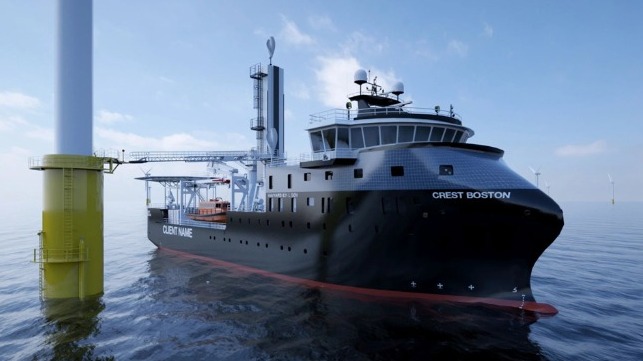Crowley and ESVAGT to Develop SOVs for US Offshore Wind Energy Sector

As the United States moves forward rapidly to develop the offshore wind energy market, there is an emerging opportunity for U.S.-flagged vessels to support the industry. U.S.-based Crowley and Danish shipping company ESVAGT are forming a partnership to meet the need for service vessels. The venture will work to develop a best-in-class design and deliver wind-dedicated, U.S.-flag Service Operation Vessels (SOV).
Consistent with the requirements of the Jones Act, Crowley will own and operate the vessels crewed with U.S. mariners, while Crowley and ESVAGT will share in the economics of the venture. ESVAGT will draw on its experience operating SOVs in Europe to provide technical advice on the design, construction, and operation of these vessels. ESVAGT pioneered the SOV concept in Europe more than a decade ago and is today the leading provider of SOV services to the European Offshore Wind Operation and Maintenance markets.
“This partnership will marry Crowley’s transferable engineering, vessel operations, project management, and logistics experience in the U.S. offshore markets to ESVAGT’s global SOV design and operations capabilities. This will enable the continued growth of sustainable, greener energy solutions by directly addressing the offshore wind service capacity challenge,” said Tom Crowley, Chairman and CEO. “Our organizations share cultures that are based around the core values of safety, integrity, and high performance. We look forward to a long and successful partnership in support of North America's new energy solutions.”
Earlier this year, Crowley formed its New Energy division strategically focused on diverse services supporting the emerging energy sectors in the U.S. and adjacent regions. Within the offshore wind industry, Crowley’s New Energy expansion, including this latest partnership, advances the company as a total lifecycle service provider. Service offerings include transportation of turbines during construction, industry-specific support vessels, shoreside terminal services, and supply chain services from farm construction through decommissioning.
“ESVAGT looks forward to further cementing its position as an offshore wind market leader by entering the U.S. offshore wind market with Crowley, a strong partner with an established track record of delivering solutions to its customers,” said ESVAGT CEO Peter Lytzen. “ESVAGT’s experience in Europe will help deliver a seamless operation in the United States, and we also appreciate the opportunity to invest in the construction of these vessels in compliance with the Jones Act.”
The National Defense Authorization Act for FY21 contained language that ensured that the Outer Continental Shelf Lands Act (OCSLA) applied to offshore wind farms including them as U.S. points for purposes of the Jones Act. The definitions made it clear that only Jones Act compliant vessels will be permitted to carry goods between U.S. ports and renewable energy projects built on the U.S. Outer Continental Shelf. Following the same model as with offshore oil and gas facilities, foreign-flag service vessels will be able to install or repair offshore installations, but they cannot carry goods or personnel from the U.S. or between the offshore installations.
Last fall, offshore vessel operator Edison Chouest announced plans to design, build and operate the first Jones Act-compliant SOV. That vessel will be dedicated to the operation and maintenance of future wind farms in the northeastern U.S. being developed by Ørsted and the utility company Eversource. Other companies have also announced plans for Jones Act-compliant vessels dedicated to installation and site work required in the development of offshore wind farms.
With states along the East Coast moving forward with the development of offshore sites, the United States has more than a dozen potential windfarm installations due to come online in the next few years. Current projects project more than 29 gigawatts installed by 2035 creating the opportunity for a fleet of SOVs to support and maintain the growing industry.
